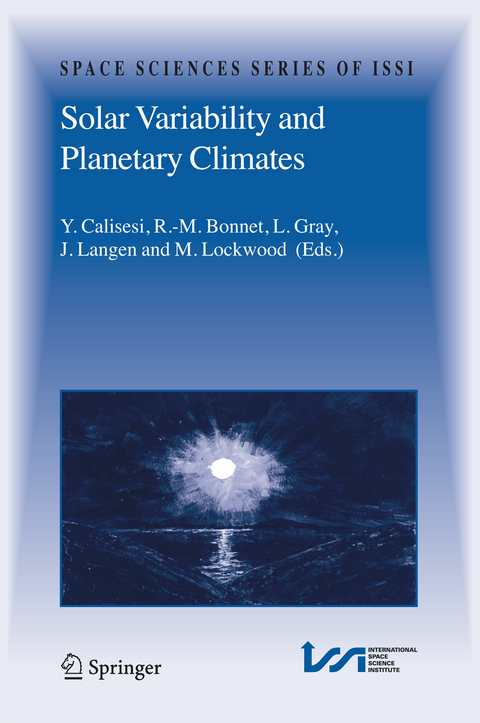
Solar Variability and Planetary Climates
Springer-Verlag New York Inc.
978-1-4419-2371-4 (ISBN)
2 With a global average irradiance of 342 W/m , the Sun is by far the largest source of energy for planet Earth. In comparison, the internal energy produced by Earth 2 itself is only about 0. 087 W/m (Pollack et al. , 1993), which in turn is 3. 5 times 2 larger than the 0. 025 W/m of heat produced by the burning of fossil fuels. About 31% (31 units) of the solar energy which arrives at the top of the - mosphere is re?ected back to space by scattering from clouds, aerosols, and the Earth’s surface. Almost 20 units of solar radiation are absorbed in the atmosphere. The remaining 49 units are absorbed at the surface. Evaporation of water at the Earth’s surface consumes 23 units, and 7 units are transferred to the atmosphere by heat conduction. On balance 19 units are lost from the Earth’s surface as infrared radiation, however consisting of 114 going upward and 95 returning from the - mosphere to the Earth’s surface (see also Rosenfeld, 2006). There is thus a sixfold recycling of energy. This is the greenhouse effect, established by the presence of watervaporandofothergreenhousegases,CO ,CH ,N O,andCFCs,intheatmo- 2 4 2 sphere. Due to human activities the latter have been increasing in the atmosphere, 2 causing climate warming through an energy imbalance of 2. 5–3 W/m , more than 100 times larger than the heat released into the atmosphere by the burning of fossil fuels.
Solar Output Variability.- Assessing Solar Variability.- Solar Variability of Possible Relevance for Planetary Climates.- Measurement of Total and Spectral Solar Irradiance.- Solar Irradiance Variability Since 1978.- Solar Variability Over the Past Several Millennia.- Solar and Heliospheric Modulation of Galactic Cosmic Rays.- What Do Cosmogenic Isotopes Tell Us about Past Solar Forcing of Climate?.- Tropospheric Aerosols, Radiation Budget, and Changes.- Observed Long-Term Variations of Solar Irradiance at the Earth’s Surface.- Aerosol Effects on Clouds and Climate.- Satellite Observations of Natural and Anthropogenic Aerosol Effects on Clouds and Climate.- Aerosol-Cloud Interactions Control of Earth Radiation and Latent Heat Release Budgets.- Atmospheric Ion-Induced Aerosol Nucleation.- Atmospheric Aerosol and Cloud Condensation Nuclei Formation: A Possible Influence of Cosmic Rays?.- Climate Change: Detection and Attribution.- On the Response of the Climate System to Solar Forcing.- Detection and Attribution of Climate Change, and Understanding Solar Influence on Climate.- The Climate Response to the Astronomical Forcing.- Regional Response of the Climate System to Solar Forcing: The Role of the Ocean.- Middle Atmospheric Response to Solar Variability.- Discussion of the Solar UV/Planetary Wave Mechanism.- Solar Variation and Stratospheric Response.- Signature of the 11-Year Cycle in the Upper Atmosphere.- The Middle Atmospheric Ozone Response to the 11-Year Solar Cycle.- Influence of the Solar Cycle on the General Circulation of the Stratosphere and Upper Troposphere.- Multidecadal Signal of Solar Variability in the Upper Troposphere During The 20th Century.- The Role of Dynamics in Solar Forcing.- Solar Influences on Dynamical Coupling Between the Stratosphere andTroposphere.- The Response of the Middle Atmosphere to Solar Cycle Forcing in the Hamburg Model of the Neutral and Ionized Atmosphere.- A Possible Transfer Mechanism for the 11-Year Solar Cycle to the Lower Stratosphere.- Recent Space Data.- Recent Space Data.- Satellite Measurements of Middle Atmospheric Impacts by Solar Proton Events in Solar Cycle 23.- Impact of Solar Activity on Stratospheric Ozone and No2 Observed by GOMOS/ENVISAT.- The Stratospheric and Mesospheric NOy in the 2002–2004 Polar Winters as Measured by MIPAS/ENVISAT.- Early Data from Aura and Continuity from UARS and Toms.- Planetary Science.- What Do We Know about the Climate of Terrestrial Planets?.- Solar Variability and Climate Impact on Terrestrial Planets.- Climate Variability on Venus and Titan.- The Orbital Forcing of Climate Changes on Mars.
| Erscheint lt. Verlag | 19.11.2010 |
|---|---|
| Reihe/Serie | Space Sciences Series of ISSI ; 23 |
| Zusatzinfo | 93 Illustrations, color; 111 Illustrations, black and white; XII, 474 p. 204 illus., 93 illus. in color. |
| Verlagsort | New York, NY |
| Sprache | englisch |
| Maße | 160 x 240 mm |
| Themenwelt | Naturwissenschaften ► Geowissenschaften ► Geologie |
| Naturwissenschaften ► Geowissenschaften ► Meteorologie / Klimatologie | |
| Naturwissenschaften ► Physik / Astronomie ► Astronomie / Astrophysik | |
| ISBN-10 | 1-4419-2371-3 / 1441923713 |
| ISBN-13 | 978-1-4419-2371-4 / 9781441923714 |
| Zustand | Neuware |
| Haben Sie eine Frage zum Produkt? |
aus dem Bereich


